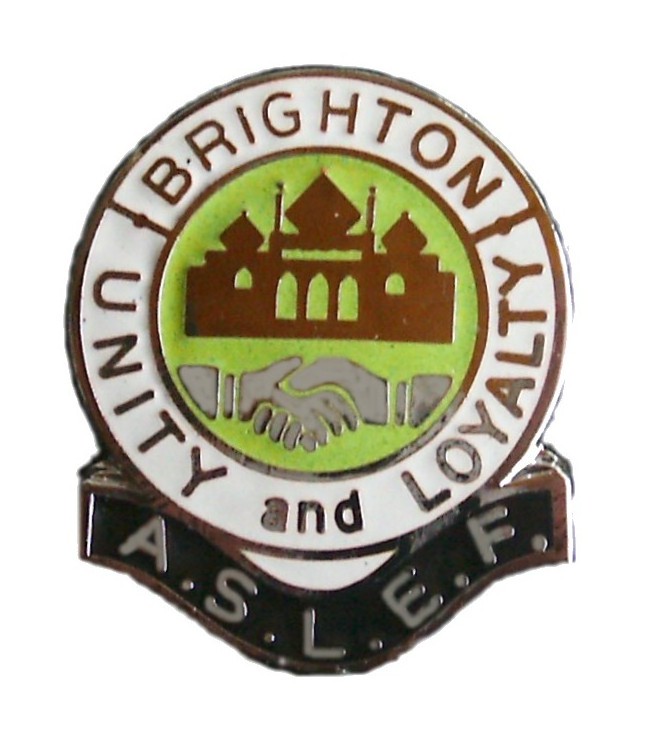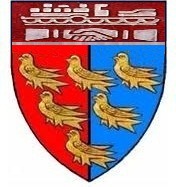A collision occurred on December 26th, 1896, at Brighton station, on the London, Brighton, and South Coast Railway. In this
case as the 1.20 p.m. train from Portsmouth Harbour was running into Brighton station the driver failed to stop it at the usual
place, and the engine came into collision with the buffer-stops at the end of No. 10 road. Thirteen passengers are reported to
have complained of injury.
The train consisted of a four-wheels-coupled tank-engine, running chimney in front, and 10 vehicles - equal to 11-including
front and rear brake-vans. The engine and train were fitted throughout with the Westinghouse automatic-brake, and there were
the usual hand-brakes on the engine and brake-vans. The engine is stated to have weighed 41 tons 6 cwt., and the weight of the
train, empty, was 112 tons 16 CWT.
The engine was practically uninjured, but there was some damage to the train, for details of which see Appendix. None of the
vehicles left the rails. The buffer-stops had a few bolts broken, and the brickwork of the platform behind them was slightly
displaced.
Description.
Approaching Brighton from the direction of Portsmouth tho line has n curve to the right of 18-chains radius.
From the south end of Hove tunnel the line rises at an inclination of 1 in 152, this gradient extending for about 22 chains; it then
rises slightly for 5 chains at an inclination of 1 in 860, and then becomes level for 3 chains up to the buffer-stops.The following
distances from the buffer-:-stop at the end of No. 10 road should be noted : -
Yards.
To the end of the platform 220 Yards
To the west signal-cabin 242 Yards
To the home-signals 308 Yards
To New England signal-cabin 484 Yards
To south end of Hove tunnel 660 Yards
The following are the rules of the London, Brighton, and South Coast Company as to stopping trains in terminal stations : -
“Engine drivers and guards are not to depend entirely upon the action and power of the Westinghouse automatic or of the
automatic vacuum brake, but, ‘When approaching junctions and terminal stations, the speed must not be greater than that which
has been usual with trains worked by ordinary hand-brakes; drivers and guards must also have their trains well under control, so
that they can be brought to a standstill with the hand-brakes, if necessary.
“Also in approaching and entering terminal stations, platform lines: &c., where other trains may be standing on the same line of
rails, the Westinghouse automatic-brake or automatic vacuum-brake must not be used, except in cases of emergency, but the
speed of the train must be so reduced that it may be brought to a stand with certainty and at the proper place, by means of the
hand-brakes alone.
“Guards must not be seated away from their hand-brakes, but must always be standing in such a position as to be able, together
with the enginemen, to promptly apply their hand-brakes, when trains are entering stations at which the trains call, as well as at
terminal stations.”
Evidence.
Thomas Dunk states: I have been 25 years in the Company’s service, 17 years a signalman. On the 26th December I came on
duty at 2 p.m. to work until 10 p.m. in the west cabin, Brighton station. We do not keep any train register book in that cabin.
We work absolute block to New England Bridge cabin on the Portsmouth line. On the above date New England offered me the
2.20 p.m. train from Portsmouth at about 3.14, which I accepted at once and pulled off all my signals. There is n distant signal
arm underneath my home-signal, which is used to indicate to the driver that the platform is clear up to the buffer-stops. I had
asked the shunter, who was close to the box at the time, whether the platform was clear. The train arrived at about 3.16 or 3.17,
and it did not run past the cabin any faster than usual; I did not notice whether steam had been shut off, or whether the brakes
had been applied. It was a wet afternoon, and not very clear.
John Smart states : I have been in the Company's service 33 years, 23 years a guard. On the 26th December I come on duty at
6.I5 a.m. to work until 6.l5 p.m. I have an hour off at Portsmouth and two hours; at Brighton. On the above date I left
Portsmouth at 1.20 to run to Brighton, with 10 vehicles (equal to 11) behind the engine, including brake-vans in front and rear. I
rode in the front brake-van, and I was guard in charge of the train. We stopped at all stations from Portsmouth Harbour to
Worthing, and also at Hove. At Goring the driver went rather too far-about two vehicles’ length before he stopped. Approaching
Brighton, steam was shut off when we were close to Now England cabin, about 300 yards from the west cabin, and I began
applying my brake about the same spot. By the time we got to the west cabin my brake would be hard on, and it certainly was
holding the wheels when we got into the station. I thought the driver had the train thoroughly under control all the time. When
the engine struck the buffer-stops I was standing up, nnd I hn.rdly felt the shock at all. I had not touched the brakes after it was
once set. The rails were in a very bad state for stopping that day, and I do not think my brake took effect so soon as it otherwise
would have done. If I have said previously that steam was shut off only at the west cabin home signal, that would be a mistake.
William Newham states; I have been 12 years in the Company’s service, 7 1/2 years a guard. On the 26th December I came on
duty at 9.55 a.m., and I booked off at 9.55 p.m., with about one hour off at Portsmouth and two hours at Brighton. On the above
date I was rear-guard of the 1.20 p.m. train from Portsmouth to Brighton. The driver over shot the proper stopping place at
Goring by about two lengths. Approaching Brighton I think the driver shut off steam just as we came out of the tunnel, near
New England signal-cabin, and just after passing that box I applied my hand-brake. By the time we got to the platform my brake
would.be hard on, and it remained so until we stopped. The automatic-brake was applied by the driver twice between New
England box and the station, and I thought he had the train thoroughly under control. Soon after my van got alongside the
platform I noticed the wheels were skidding. The automatic-brake was applied again before we stopped. I did not know we had
come into collision with the buffer-stops until 1 got out of the van. The rails were very wet.
George Batchelor states: I have been 19 1/2 years in the Company’s service, 13 years a driver. On the 26th December I came on
duty at 1.45 p.m. at Littlehampton, and I had been on duty on Christmas Day from 9 a.m. to 2 p.m. I took over engine No. 255,
with the 1.20 train ex Portsmouth, at Ford junction, at about 2.30. That engine is a four-wheels-coupled tank-engine, fitted with
the Westinghouse automatic and hand-brakes. The engine was running chimney in first. We stopped at Angmering, Goring,
West Worthing, Worthing, and Hove. At Goring I released the brake a little too soon, and overshot the proper stopping place a
van length or so. Approaching Brighton, New England cabin signals were”off'" for' me, and also al1 signals worked from the
west cabin. Just after we came out of Hove tunnel I shut off steam, and I did not open the regulator again. My mate put the hand
brake on before we got to the west cabin, and I reduced speed a little with the automatic brake, and just at the end of the
platform. At the end of the platform the speed would be about six miles an hour, no faster than usual. For two years I have been
in and out of the station. The engine is not one I have had before, but it is just the same class of engine I have worked regularly.
About four lengths away from the buffer stops I fought we were going a little too fast with the hand brakes, and I put on the
automatic brake. I do not think the engine wheels picked up at all. There are two sand boxes each end of the engine. I opened
the leading boxes just before we struck the buffers. It was a dirty day, and the rails were in a bad state. I can give no reason why
we did not stop clear of the buffers. I did not feel the collision at all.
Henry Pullen states; I have been 12 years in the Company’s service; six years a fireman. On December 26th i was firing for
driver Batchelor, and my hours of duty were the same as his. Steam was shut off at the Brighton end of the tunnel, and I applied
my brake coming past New England signal west cabin. The speed, which was no faster than usual, would be about five miles an
hours passing the west cabin. My brake appeared to take hold of the wheels all right. The train was on carriage heavier than
usual. About half way along the platform I said to my mate I did not think we should stop, and he applied his brake. The latter
did not seem to stop the as it should have done, but the engine wheels did not skid. I did not feel the collision, and we had
almost stopped when we touched the buffers. the sand boxes were opened by my mate just at the last. I thought I had the train
well in hand.
Conclusion.
This buffer-stop collision was only a slight one, but, as is generally the case, several passengers sustained injuries, due probably
to the fact that they were standing up in readiness to alight from the train. The train was amply provided with brake.power, and
it is not alleged that the brakes failed to act properly when they wore applied; the only excuse offered is that the rails were in an
exceptionally bad state, owing to rain.
The platform is approached, from the Portsmouth line, on a rising gradient of 1 in 152, and it is stated that steam was shut off
about 400 yards outside the station; also that the hand-brakes on the engine and front and rear brake-vans were applied before
the west cabin was reached, about 300 yards from the buffer-stops.
The driver appears to have steadied his train, outside the station, with the automatic- brake, and he estimates the speed on
entering the station at six miles an hour. If the statements of the driver, fireman, and guards are correct, it is certainly difficult to
imagine why any collision with the buffer-stops should have taken place; but, as the driver had made a slight miscalculation at a
previous station (Goring), having failed to stop the train at the proper place there, it would appear as though he had not realised
as fully as he should have done the greasy state of the rails, and that he did not reduce speed sufficiently outside the station. I am
also of opinion that sand was not utilised, to counteract the greasiness of the rails, to the extent it might and should have been.
Driver Batchelor had, on this occasion, an engine which was strange to him, but of a type with which he is quite familiar, and
there was a carriage more than usual on the train-facts which are, however, little excuse for mismanagement on the part of a
driver of so many years’ experience.


